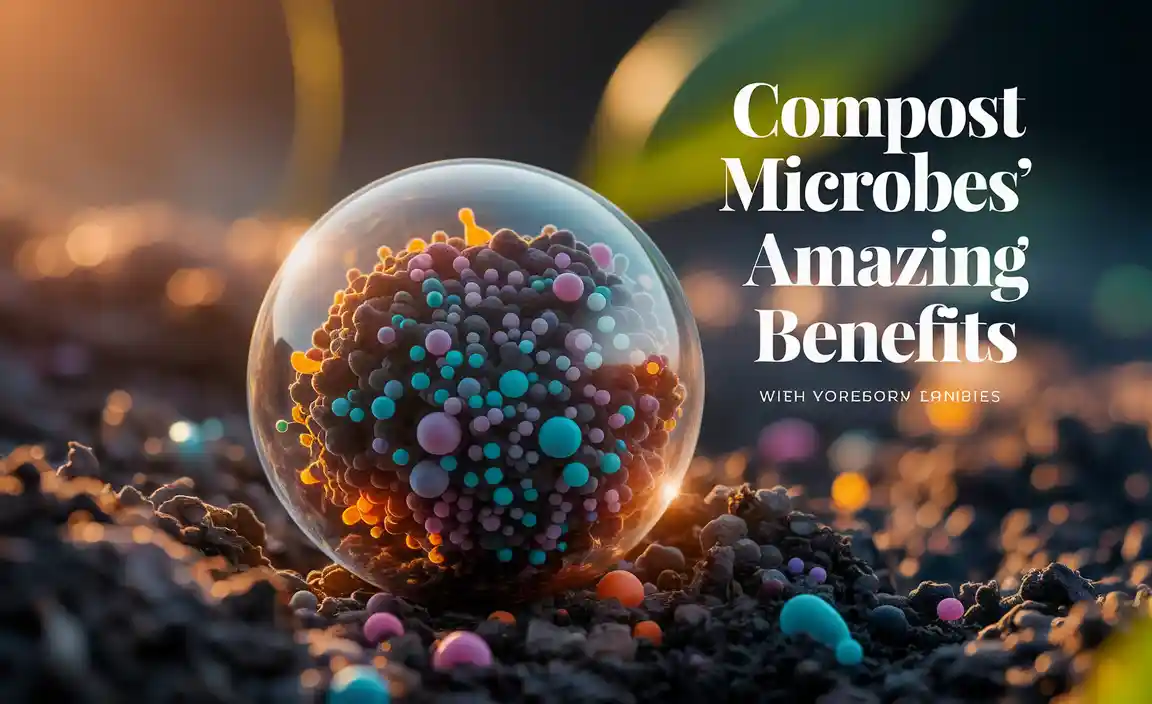Ever look at kitchen scraps and garden waste and think, “There has to be a better way than just tossing it”? You’re not alone! Many of us feel a little lost when it comes to composting. It seems like a big, complicated process, but what if I told you it’s actually quite simple and incredibly rewarding?
I’m Troy D Harn from TopChooser, and I’m here to break down composting into easy, manageable steps. Think of me as your friendly neighbor showing you how to get this done without any fuss. We’ll cover everything you need to know, from what goes in to how your compost pile turns into nutrient-rich goodness for your garden.
Ready to transform your waste into black gold? Let’s dive in!
Why Compost? The Amazing Benefits You Can’t Ignore
Composting might sound like just another chore, but it’s actually one of the most beneficial things you can do for your home, your garden, and the planet. Let’s look at a few reasons why it’s a no-brainer.
Reduce Waste, Save Money
Did you know that food scraps and yard waste make up a significant chunk of what we throw away? Composting diverts this from landfills. Less trash means potentially lower waste disposal fees. Plus, you’ll create your own fantastic soil amendment, saving you money on buying bags of compost or fertilizer for your plants.
Boost Your Garden’s Health
Compost is like a superfood for your soil. It improves soil structure, helping it retain moisture and air. This makes it easier for plant roots to grow and access nutrients. Healthier soil leads to healthier, more vibrant plants and bigger harvests. It’s a natural way to give your garden a serious upgrade.
Eco-Friendly Superstar
When organic matter decomposes in a landfill without air, it produces methane, a potent greenhouse gas. Composting, on the other hand, is an aerobic process (meaning it needs air) and significantly reduces these harmful emissions. You’re actively helping the environment simply by managing your waste responsibly. It’s a win-win!
Getting Started: What You Need for Composting Success
The beauty of composting is its flexibility. You don’t need fancy equipment to get started. Here’s a look at the basic components you’ll need to consider.
Choosing Your Composting Method and Bin
There are several ways to compost, depending on your space and how much material you generate. Here are some popular options:
- Open Pile: The simplest method. Just pile your materials in a corner of your yard. It’s free and easy but can look a bit messy and might attract pests if not managed well.
- Enclosed Bin: These can be made from wood, wire mesh, or repurposed materials like old pallets. They help contain the compost, keep pests out, and retain moisture and heat. Many store-bought bins are available, or you can DIY one.
- Tumbler: These are rotating barrels that make it super easy to mix your compost. They often speed up the composting process and are great for keeping pests at bay, but they can be more expensive.
- Worm Composting (Vermicomposting): Perfect for apartment dwellers or those with limited space. Red wiggler worms do the work in a special bin, turning food scraps into nutrient-rich worm castings.
The Core Ingredients: Greens and Browns
Successful composting relies on a good balance of “green” and “brown” materials. Think of it like a recipe; getting the mix right is key.
| Greens (Nitrogen-Rich) | Browns (Carbon-Rich) |
|---|---|
| Fruit and vegetable scraps | Dry leaves |
| Coffee grounds and tea bags | Shredded newspaper and cardboard (avoid glossy ink) |
| Grass clippings (in moderation) | Straw or hay |
| Plant trimmings | Wood chips or sawdust (small amounts) |
| Eggshells | Pine needles |
Aim for a ratio of about 2 to 3 parts browns to 1 part greens by volume. Too many greens can make your pile slimy and smelly, while too many browns will slow down decomposition. Don’t stress too much about the exact ratio initially; you’ll get a feel for it.
What NOT to Compost
To keep your compost healthy and avoid attracting unwanted visitors or spreading disease, there are a few things to keep out:
- Meat, fish, and bones
- Dairy products
- Oily or greasy foods
- Diseased plants
- Pet waste (dog and cat feces)
- Weeds that have gone to seed
- Chemically treated wood or yard waste
Essential Tools (Keep it Simple!)
While you can start with just your hands and a shovel, a few basic tools can make the process smoother and more efficient:
- Pitchfork or Garden Fork: Great for turning and aerating your compost pile.
- Shovel: Useful for moving materials and harvesting finished compost.
- Watering Can or Hose with a Sprayer: To keep your compost moist.
- Kitchen Caddy: A small bin with a lid to collect your kitchen scraps before taking them to the main compost bin.
- Optional: Compost Thermometer: Helps you monitor the temperature of your pile, indicating microbial activity.
Your Step-by-Step Composting Training
Now that you know what you need, let’s get composting! Follow these simple steps, and you’ll be on your way to creating your own compost in no time. Remember, patience is key!
Step 1: Select Your Composting Location
Choose a spot that is convenient for you to access, ideally with good drainage. Partial sun is generally best; too much sun can dry out the pile, while full shade might keep it too wet and slow decomposition. Make sure it’s not too close to your house or seating areas, as a well-managed compost pile shouldn’t smell bad, but it’s good practice.
Step 2: Start Building Your Pile
Begin by laying down a base layer of bulky brown materials, like twigs or straw. This helps with aeration from the bottom. Then, start layering your greens and browns. A good starting point is to put down a layer of browns, then a layer of greens, then more browns, and so on. Chop or shred larger items to help them break down faster.
As you add kitchen scraps (greens), try to bury them under a layer of brown material. This is a great tip to avoid attracting pests and to help manage odors.
Step 3: Maintain Moisture Levels
Your compost pile needs to be about as damp as a wrung-out sponge. If it’s too dry, decomposition will slow down. If it’s too wet, it can become anaerobic and start to smell. Water the pile as it’s being built, especially when adding dry brown materials. You can also check moisture by squeezing a handful – a few drops of water should come out.
You can find more information on maintaining moisture and temperature for optimal composting from resources like the Environmental Protection Agency (EPA).
Step 4: Aerate & Turn Your Pile
Microbes need oxygen to do their work. Turning your compost pile introduces air and helps the materials break down evenly. Aim to turn the pile every 1-2 weeks. You can use your pitchfork to mix the outer layers into the center and vice-versa.
If you have a compost tumbler, simply rotate it every few days. This is why tumblers are so popular for busy folks – they make aeration a breeze!
Step 5: Monitor and Be Patient
Composting is a natural process, and the speed at which it happens depends on the materials, temperature, moisture, and how often you turn it. In warm weather, with good management, you could have finished compost in as little as 1-2 months. In cooler weather, it might take 6 months to a year. Don’t get discouraged if it takes longer than you expect.
You’ll know your compost is ready when it looks and smells like dark, crumbly soil. You shouldn’t be able to recognize the original materials you put in.
Step 6: Harvest Your Black Gold!
Once your compost is ready, you can start using it. You can harvest it from the bottom of a bin or from one side of an open pile, as this is usually where it finishes first. Sift it through a screen if you want a finer texture, removing any undecomposed larger pieces to add back to your active pile.
Troubleshooting Common Composting Issues
Even with the best intentions, sometimes things don’t go exactly as planned. Here are a few common composting hiccups and how to fix them:
My Compost Pile Smells Bad
A strong, unpleasant odor (like ammonia or rotten eggs) usually means the pile is too wet or has too many green materials. This indicates an anaerobic condition (lack of air).
- Solution: Add more brown, carbon-rich materials like shredded cardboard, dry leaves, or sawdust. Turn the pile thoroughly to introduce air and help it dry out. Avoid adding very wet food scraps until the smell dissipates.
My Compost Pile Isn’t Heating Up or Breaking Down
This usually means the pile is too dry, has too many brown materials, or isn’t large enough to generate heat. Decomposition is a biological process that needs the right environment to thrive.
- Solution: Add water until it’s moist like a wrung-out sponge. Add more green, nitrogen-rich materials like fresh kitchen scraps or grass clippings. Ensure your pile is at least 3x3x3 feet to effectively build and retain heat.
I See Pests in My Compost Pile
If you’re seeing rodents or excessive flies, it’s usually because you’re adding meat, dairy, or oily foods, or not burying your kitchen scraps properly.
- Solution: Remove any prohibited items immediately. Always bury fresh food scraps deep within the pile and cover them with a layer of brown material. Using an enclosed bin or a tumbler can also deter pests effectively. Ensure your bin doesn’t have large gaps.
Using Your Finished Compost
Ah, the moment of truth! You’ve successfully composted. Now, what can you do with this amazing, nutrient-rich material?
For Your Garden Beds
Mix compost into your garden soil in the spring or fall. It enriches the soil, improving its structure, drainage, and ability to retain water. A layer of compost on top of the soil (about 1-2 inches) acts as a mulch, suppressing weeds and keeping moisture in.
For Potted Plants
Compost is fantastic for container gardens! Mix it with potting soil to create a richer blend. A common mixture is about one-third compost, one-third peat moss or coir, and one-third perlite or vermiculite for good drainage. Remember to use sifted compost for pots to ensure a consistent texture.
For Your Lawn
Top-dress your lawn with a thin layer of compost (about 1/4 to 1/2 inch

I am passionate about home engineering. I specialize in designing, installing, and maintaining heating, ventilation, and air conditioning systems. My goal is to help people stay comfortable in their homes all year long.


